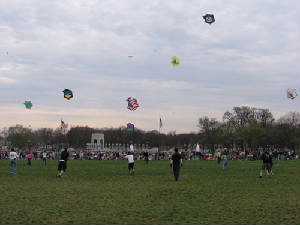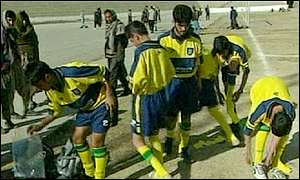|
Kite Fighting

In kite fighting, the materials used to create the kite
usually include: Mylar, aircraft
insulation, nylon, and polyester thin plastic sheeting for the actual kite and
bamboo fiberglass, or carbon fiber for the spars. Recently, synthetic lining
has been used and is usually coated with multiple different abrasives and
strong glue. Some cultures however, use metal lining to attach metal knives to
and use the knives to cut the opponent’s line. In kite fighting, the winner is
the person whose kite is still flying by the end of the tournament. The most
common types of ways to cut an opponents line are release cutting, feeding the
line from your spool out, or pull cutting, pulling in the line from your kite.
There are a lot of factors which affect the outcome of who will win. They are
the size of the kite, the quality of the kite, the quality of the line, the
quality of the abrasive on the line, the quality and size of the spool, the
spool handler, initial contact, the skill of the person flying the kite, and
the wind conditions. All of these factors influence the way the kite flies and
whoever eventually wins. The different types of competitions are line touch,
line cutting, and capture or grounding competitions. Line touch competitions
are when a referee says either top or bottom and the kite fliers try to touch
the opponent’s line on either the top or bottom. Line cutting competitions are
when the kite fliers have to cut the string of the opponent’s kite and the last
person left is the winner. Grounding or capture competitions are when the kite
fliers have to capture and bring the opponent’s kite to the ground. -Gomal JH
Boxing
Today in the world
of boxing, Amir,
the “Timid”, took on, “Brass Knuckles”, Assef.
The fight started out clean until Assef decided to
bring out his
infamous brass knuckles. Amir took
several shots and is now hospitalized from major injuries to the face and
chest. Amir suffered several broken ribs, some minor fractures, but worst of
all a broken jaw. He will be receiving
his meals out of a feeding tube after the brawl that occurred. However, after
the fight was over, “Brass Knuckles”, Assef, was also critically injured due to
a shot to the eye he suffered when a young spectator did not like the way the
fight was going. Assef and Amir are expected to recover. Assef however, will
lose sight in his one eye. -Madiha TS
Football

|
| Pamir's Football Players |
Here in Kabul, where
although football has not been widely promoted under the Taliban rule, it is still permitted but with
restrictions. Players are not aloud to wear shorts and fans are not aloud to
cheer with the risk of being shot by guards within the stadium. The Taliban even used the stadium for public executions,
often before soccer matches. Fans have even become secretive about how they are
fans because of the ban on TV's, and the running risk of getting in trouble
with the Taliban. The stadium, although may be
full, is silent aside from the thumping of the ball and the occasional risk
cheer. -Nazir
TK
Kite Running

|
| Three Children Showing Off Their Prize |
Kite Running is an extremely exciting pastime in many Middle
Eastern countries including India,
Pakistan, and Afghanistan.
People of all ages watch and participate in this exciting event which follows
the exhilarating fighting of the kites. After a kite is cut during the fight
people rapidly follow the descending kite until it comes within reach and they
grab it. A fallen kite is a prized trophy to achieve. It is a sign of triumph
among mostly children but also all others. Running a kite can be extremely
dangerous. Many have died while participating in the exciting chase. In most
cases those who die are so fixated on the kite that they do not realize where
they are going and often times end up in dangerous places such as busy streets.
In some instances people are hit by cars and trains. People also die from
falling off buildings and trees that they have to climb to reach the kite. Even
though some may perish while participating, kite running still remains one of
the most fun pastimes in the Middle East that
children take part in. -Taj JK
|

